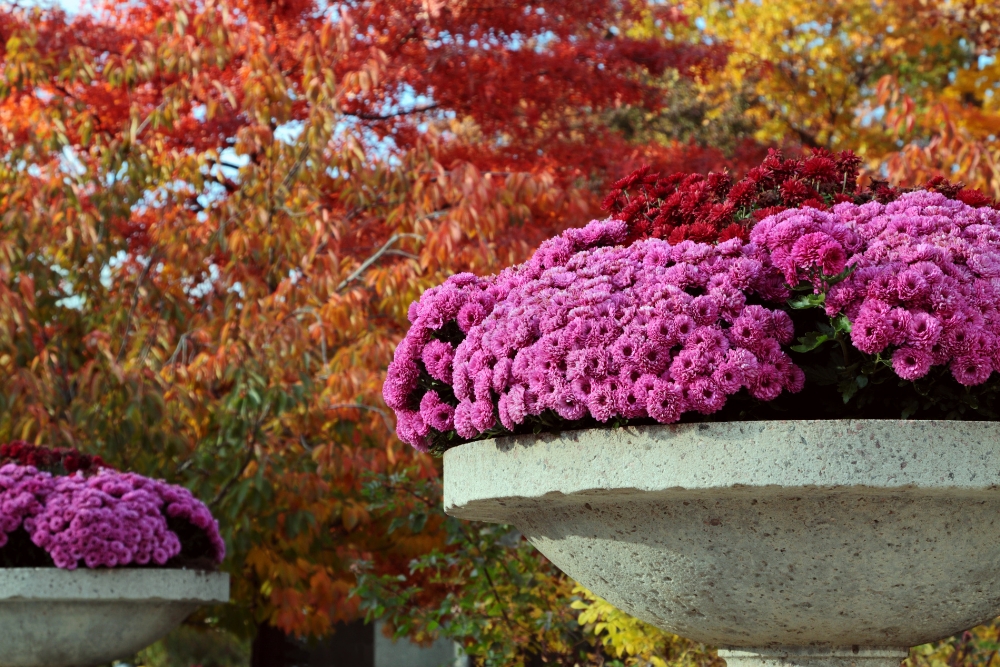
As the crisp autumn air settles over Sydney, the vibrant hues of summer slowly give way to a warm palette of oranges, reds, and yellows. But the beauty of your garden shouldn’t fade with the flowers! By incorporating the magic of texture into your autumn garden design, you can create a captivating space that engages the senses year-round.
The texture goes beyond just colour, adding depth, dimension, and a touch of drama to your outdoor haven. Imagine strolling through your garden, the soft caress of feathery foliage contrasting with the spiky sensation of Kangaroo Paws – a sensory experience that elevates your autumn garden beyond the ordinary.
What makes a textured garden?
Texture in garden design refers to the visual and tactile qualities of the plants and elements within it. Think smooth, feathery leaves next to rough, barky branches. Imagine the soft caress of ornamental grasses against the prickly sensation of a cactus. Here’s how to achieve a textured haven:
- Foliage: Explore the vast array of leaf shapes and textures available. From the feathery fronds of ferns to the spiky needles of conifers, each plant adds a unique visual element. Don’t forget about the texture of evergreen foliage, which provides a constant backdrop for fall colour.
- Bark: Look beyond the leaves! Tree bark comes in a variety of textures, from the smooth, papery bark of a paperbark tree to the deeply furrowed bark of an Angophora. Include trees with interesting bark textures for year-round visual interest.
- Flowers: Even in autumn, your garden can bloom with texture and a touch of colour. Look for autumn flowers that bring colour to the garden with feathery seedheads, like ornamental grasses, or spiky blooms, like kangaroo paws.
Why is texture important in an autumn garden?
As summer fades and leaves begin to change, the vibrant colours of spring and summer give way to a more subtle palette. Texture steps up to fill the void, adding visual interest and creating a captivating space. Here’s how:

- Maintains visual interest: When flowers fade, texture takes centre stage. By incorporating a variety of textures, you create a visually stimulating garden that remains captivating throughout autumn.
- Depth and dimension: The strategic use of texture can create a sense of depth and dimension in your garden. Planting contrasting textures next to each other draws the eye inward, making your garden appear larger and more intriguing.
How can texture be used to create a specific mood?
While not the sole focus, texture can subtly influence the mood of your garden. For example, soft, feathery foliage and rounded pebbles create a sense of calm and tranquillity, while spiky plants and sharp rocks evoke a feeling of excitement and energy.
What plants offer textural interest in a Sydney autumn garden?
Sydney boasts a wide variety of plants that add textural interest to your autumn haven:
- Foliage:
- Feathery: Lomandra (strap lily), Kangaroo Paw ferns
- Spiky: Dianella (flax lily), Phormium (New Zealand flax)
- Glossy: Lilly Pilly (Syzygium Australe), Acmena Smithii (Acmena)
- Bark:
- Peeling: Melaleuca (paperbark tree), Corymbia ficifolia (pink flowering gum)
- Furrowed: Angophora (Sydney Angophora), Eucalyptus (gum trees)
- Flowers (Autumn):
- Feathery seedheads: Stipa gigantea (giant feather grass), Pennisetum (fountain grass)
- Spiky blooms: Kangaroo Paws (Anigozanthos), Grevillea (spider flower)
How to use colour and texture together in your autumn garden?
Don’t underestimate the power of combining colour and texture! Here are some tips:
- Contrasting textures: Highlight the warm hues of fall foliage by planting them next to plants with contrasting textures. For instance, pair red maple leaves with the soft, feathery foliage of ornamental grasses.

- Complementary textures: Create a cohesive look by using plants with similar colour palettes but contrasting textures. For example, plant burgundy-coloured Cordyline (cabbage tree) with burgundy-coloured Phormium (New Zealand flax) – one with smooth, glossy leaves and the other with spiky, upright foliage.
Can you use non-plant elements to add texture?
Absolutely! Decorative elements like rocks, pebbles, and garden ornaments can add another layer of texture to your autumn haven. Consider using smooth river stones to create a pathway bordering a bed of plants with spiky foliage. Or, position a weathered birdbath with a rough, textured surface amongst smooth pebbles for added visual interest.
How do you design your textured autumn garden layout?
When arranging your plants for maximum textural impact, keep these tips in mind
- Focal points: Create a captivating scene by using plants with bold textures as focal points. A tree with peeling bark like a Melaleuca (paperbark tree) can be a stunning centrepiece, while a bed of spiky Dianella (flax lily) can draw the eye to a specific corner of your garden.
- Layering: For a captivating sense of depth and dimension in your autumn garden design, avoid planting everything at the same height. Layer your plants strategically. Start with taller plants boasting interesting bark or foliage in the background, followed by mid-sized shrubs with contrasting textures in the middle ground. Finally, finish with low-growing textural plants like ornamental grasses or creeping groundcovers in the foreground.
What maintenance is required for a textured autumn garden?
The beauty of a textured garden is that it can be relatively low-maintenance. However, some basic care is required to keep your plants thriving:
- Watering: Follow the specific watering needs of your chosen plants. Generally speaking, established plants will need less frequent watering in autumn compared to summer.
- Pruning: Some plants may benefit from light pruning in late autumn or early winter to maintain their shape and encourage new growth.
- Mulching: To help your plants thrive, spread a layer of mulch around their base. This retains moisture in the soil, discourages weeds from sprouting, and regulates soil temperature.
Embrace the magic of texture in your Sydney autumn garden
By incorporating texture into your autumn garden design, you create a captivating space that engages the senses year-round. From the soft caress of feathery foliage to the dramatic contrast of spiky plants, texture adds depth, dimension, and a touch of drama to your garden. So, embrace the magic of texture this autumn and transform your outdoor space into a haven of visual and tactile delight.
Transform your outdoor space this autumn! Let All Green Gardening help you create a captivating textured haven in your Sydney garden. We’ll guide you through plant selection, layout design, and all the tips you need to bring your vision to life. Imagine strolling through your garden, surrounded by the beauty of texture – the soft caress of feathery foliage, the dramatic contrast of spiky plants, and the warmth of the autumn sun. Contact us today and start planning your own textured masterpiece!
